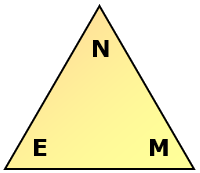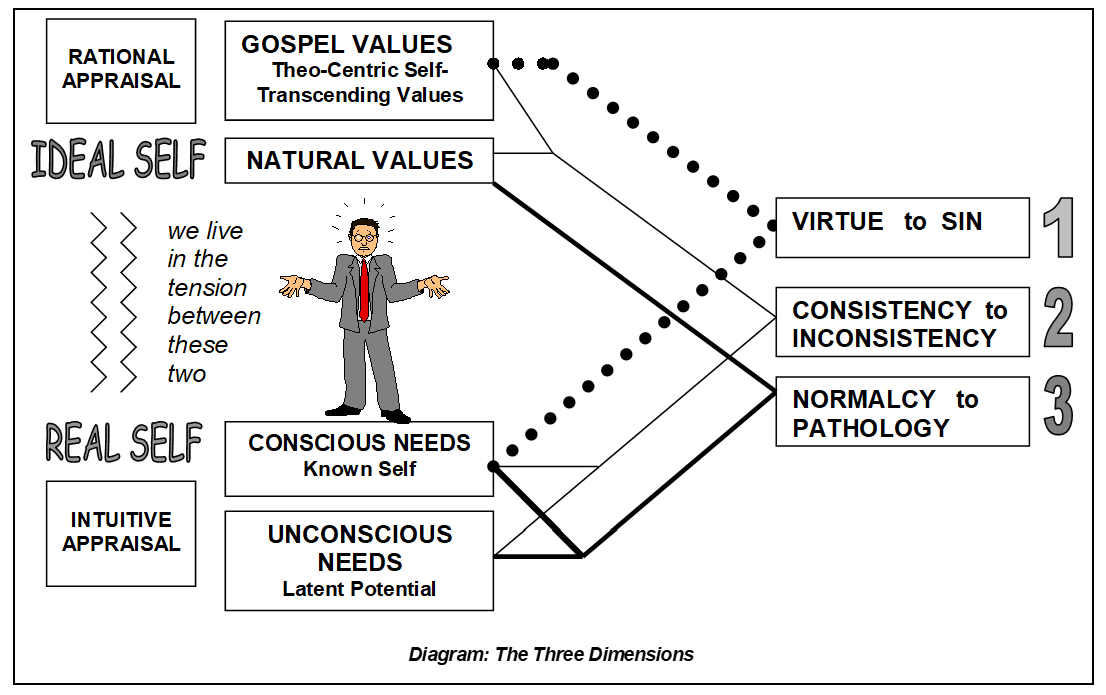
We have looked briefly at the tension between our Conscious Needs and Unconscious Needs on one hand, and our Human and Theo-Centric Self-Transcending Values on the other. We saw how our perception of reality can be influenced by our needs especially when they have been over-met, under-met, or distorted by hurts or expectations. What does this mean for our Christian living and what implications does the interaction of our needs and values have on our Christian decision-making especially in responding to a perceived religious or ministerial vocation.

The Real Self
We all live with the inescapable reality of our individual human limitations. This is what we might call our real or actual self – who I really am with the reality of my personal behaviour. These limitations include my basic human needs. Needs operate at both conscious (known to self) and unconscious (latent potential) levels; in other words, some are known to me and others are waiting (latent) to be triggered into action (potential).

Needs are primarily hidden in the unconscious, and are brought to the pre-conscious mind in anticipation of being used. In this way needs are the motivating force behind our intuitive appraisal in which we interpret experience according to whether or not the stimulus is beneficial subjectively, regardless of its intrinsic value. This motivating force is a felt action tendency which we call emotion. Such felt action tendencies are fundamentally bio/chemical in origin and therefore bodily reactions and memories. For example, someone angers me and I yell back automatically, without even bringing the process to awareness.
Thus the Triad here is; Needs / Emotional / Memory (Intuitive Appraisal).
The Ideal Self
A second set of motivating forces draws us away from our experience of limitation. Shame and guilt, fear, anger and other emotions, as well as our vulnerability and dependence on external factors for survival and our feelings of well being unsettle us. Hence we are attracted to a more acceptable idea of self which we call here the ideal self. This image refers to the kind of person I would like to be and is governed by what I value or see as important in my life. The values behind this ideal give me guidance and call me to seek such things as truth, integrity, authenticity, simplicity, right relationship, confidence, and many others in the quest for better self.

Some values are basic to healthy human life and are called Natural or Human Values. Other values concern spiritual or moral directions and draw us towards God and are therefore called Self-Transcending Theo-Centric values.
Values are motivations belonging to the conscious mind or intellect. They are therefore elements of human thought and reflection. Rational Appraisal is the operation by which values are deliberately chosen as motivations for decision and action. Values are chosen because they have intrinsic objective value apart from the subject state of mind or emotion. For example, a person can choose to live as a Christian despite the fact it may involve considerable sacrifice.
Thus, the Triad here is; Values / Intellect / Rational appraisal
The Three Dimensions
The interaction of needs and values illustrates three dimensions of motivation and consequence in the human person. The three dimensions are;

DIMENSION ONE – Virtue to Sin

The first dimension describes the nature of Sin and Virtue, and is a measure of the tension between conscious needs and Gospel values. Needs which are conscious to us are needs we have choice around. Christians understand that if we choose to deliberately act against the values of the Gospel then we place ourselves in conflict with what is moral, making our behaviour immoral and placing us in a state of Sin. Sin is an intentional transgression against what we know to be objectively right according to the Gospel of Jesus. The opposite is true for behaviour that is in accord with the Gospel. We call this behaviour Virtue.
So, the key components of Dimension One are full consciousness at the time of action and behaviour is either contrary or according to the objective moral norms of the Gospel. Thus, there is only Sin or Virtue, black or white; there is no grey zone to complicate matters.
Know therefore that the Lord your God is God; he is the faithful God, keeping his covenant of love to a thousand generations of those who love him and keep his commandments.
Deuteronomy 7:9
DIMENSION TWO – Consistency to Inconsistency
Now just when matters of motivation seem simple and straightforward, we move to examine what may be called “the grey-zone”. In the second Dimension understanding human motivation becomes quite complex and uncertain. This dimension is a dialectic between both Conscious and Unconscious Needs and Natural/Human Values and Gospel Values. What makes it more difficult to discern the influencing psychological forces is the presence of Unconscious Needs. Behaviour that can seem on the surface to be quite ‘normal’ may in fact be ‘hiding’ multifaceted drives.
In a person’s life this dimension shows itself in one of two main ways:

- In Inconsistency, between what is of value to them and their actual behaviour. For example a religious confrere is seldom at community gatherings and skips private prayer. Inconsistencies are present because according to his religious vocation he professes to value both the common life and the centrality of prayer and yet this is at odds with his present behaviour. External observation might lead us to judge the brother’s actions in a black and white way. But unbeknown to both observer and the brother himself are unconscious needs. Perhaps his vocational profession is less a choice about religious discipleship and more in truth about meeting his own strong affective and abasement needs, pulling him away from others and from God. Hence the observable data conceals a more hidden and less black and white agenda.
- Conversely, Dimension Two may show itself in the Consistency between the held values and actual behaviour. For example a certain woman is concerned for the poor. She is often talking to others about the need to own less herself and give generously to those less better off (Gospel value of charity). Because this is important to her, she has set up a shelter for homeless people and she gives any money she receives, to support those who come for help. In her present behaviour she prays for the poor and lives simply in every aspect of her life. She has a good knowledge of her need to nurture and organize others and so uses them consciously to get done what has to be done, while being cautious not to smother and dominate them. She believes in helping others to help themselves rather than taking over to meet her own needs. This woman has a high degree of consistency between her professed values and her needs both conscious and unconscious, primarily because she works to keep them in consciousness and secondarily because her needs are not in direct opposition to her values.
So, Dimension Two does not consist of two mutually exclusive poles as in the first dimension. Rather, it is more like a sliding incremental scale. At one end needs and values are highly consistent with each other, while at the other end the soaring inconsistency indicates that a person’s motivations (needs and values) are very mixed and may be incompatible. As you can imagine important implications for the Christian vocation result, particularly in the arena of vocational discernment and more broadly the discernment of God’s Will.
All that we can comment on in Dimension Two is the degree of consistency or inconsistency present. No more exact interpretation is accurate. The potential “grey-zone” is always hanging over a more precise definition. Consequently, we cannot speak of sin or virtue with this dimension, moral certitude is unknowable; all we are left to ascertain is the degree of culpability present in the person’s intentions.
Culpability is the measure of a person’s objective guilt. When some motivating factors are hidden even to the individual themselves, responsibility for behaviour and freedom of will are limited to the same degree. This is clearly evident in a situation like a drunken driver killing a pedestrian. Can we say that the driver was of sound mind and knew what he was doing? Or does his intoxication free him from any blame? One court might charge him with drink driving, while another might consider manslaughter because he chose to drive when he had been drinking thus choosing a potentially dangerous behaviour. Choices have consequences.
Thus, does a person claiming to have a religious vocation also have enough conscious freedom to make the choice in a mature, responsible way, or could other extenuating influences mean potential unresolved needs impede their religious living? How free are we in the second dimension?
So then, just when we thought it was all clear, we have to consider another complicating factor, the Defensive posture. This also may show itself in two exclusivities.
- Sometimes there is Defensive Consistency. For example a teenager does everything her father tells her to do. She believes that respecting her parents and obedience to them is important. But she is afraid of her father and avoids getting into trouble by doing just enough of what he says so that she won’t attract her father’s notice. Because of her need to avoid getting into trouble, the daughter is defensive around her father’s authority and her obedient behaviour is more about avoiding punishment than parental respect. Her behaviour is consistent with Gospel values, but the underlying attitude is defensive which is inconsistent with the Gospel, by which we are called to act out of love not fear.
- Secondly, we can identify Defensive Inconsistency. For example the parish catechist believes that the peace that Jesus Christ brings into the world is an awesome gift and he can often be heard speaking the words “Peace be with you” when he goes into their homes. However, his unconscious needs for aggression and dominance are strong. He tends to dominate others and can get quite angry with people when they don’t do what he wants. Recently at a parish function, after wishing the people “the peace of Christ” he went on an angry tirade accusing them of not being committed to their faith. They are in fact reticent to get involved because of his anger. The Parish Priest has mentioned this to him, and the Catechist smiles peacefully at the priest saying, “Yes, Father.” Lately he has been blaming the priest for the problems behind his back. The behaviour of the Catechist is inconsistent with the Gospel values of peace, gentleness, honesty and obedience. Furthermore, such defensive behaviour as smiling through one’s anger and blaming are unconsciously being used by the catechist to avoid acknowledging his own needs and the tensions these are creating.
DIMENSION THREE – Normalcy to Pathology

Like Dimension One this dimension is also very clear. When Natural/Human Values, which motivate a person to live with a degree of normal functioning, are in harmony with Conscious and Unconscious Needs a person is said to be behaving normally or healthily. Normal behaviour is of course relative to standard of living and means; however, it would still be safe to assume that a normal, healthy functioning body and mind is a desirable value for all humans.
When natural/human values are in conflict with needs a person is suffering from a degree of pathology. Sickness is the common result of the person who does not value ‘normal’ matters of health, hygiene for example. In eating disorders, the natural value of health and beauty is in conflict with the conscious need to eat and the unconscious need for abasement which translates in behaviour as problematic fasting or eating. Examples abound of both physical and psychological pathologies that result directly from need / value conflict.
In summary, we are observing the third Dimension when Natural/Human Values, are in either harmony (Normalcy) or conflict (Pathology) with Conscious and Unconscious Needs.
So, the three Dimensions give us some clarity about the forces operating within us. They show us that very little of what we may consider in the moral realm is clear-cut and black and white. Unknown needs frequently complicate simple interpretations of our behaviour. Furthermore, the Dimensions show us how attitudes are developed and strengthened as unconscious life patterns on which our behaviour is based. In the next section we will being exploring attitudes, what they are, how they are formed, and what impact they have on our lives.
With our Founder, we contemplate Jesus Christ, united to his Father with bonds of love and trust. Filled with the Holy Spirit, Jesus gave thanks to his Father for having revealed himself to little ones; for he was his Servant, deeply involved with the poor and with sinners.
In the words of Father Chevalier, “He was happy to pour out the tenderness of his Heart on little ones and on the poor, on those who suffer and on sinners, on all the miseries of humanity.
The sight of any misfortune moved his Heart with compassion.”
MSC Constitutions #6
